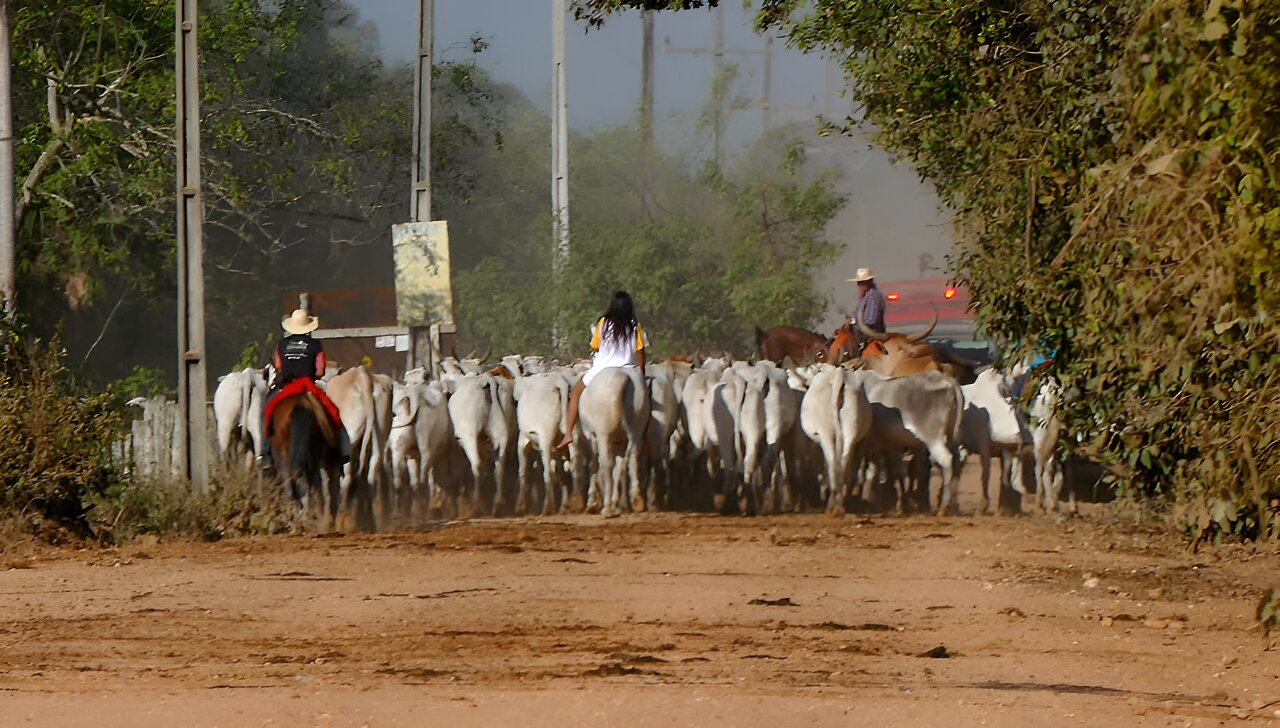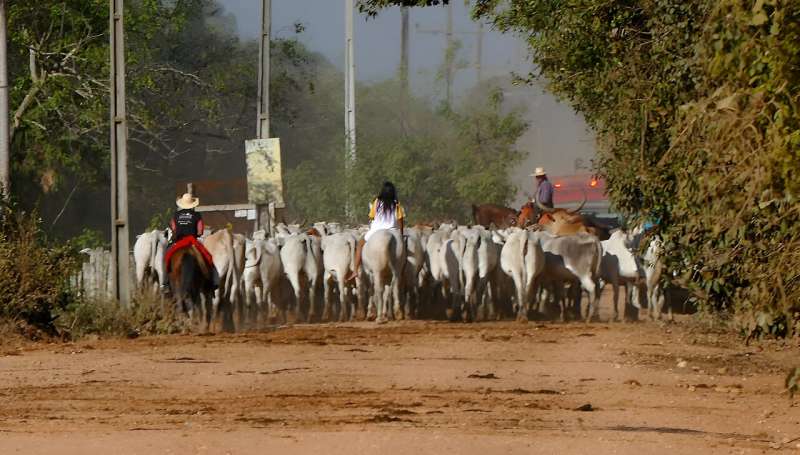

Dense forest and patchy regulations mean Latin America is struggling to shake off its mantle as the world’s leading emitter of greenhouse gas from livestock production.
“When extensive deforestation occurs … it drastically modifies the rural and urban environment through hydrologic imbalance, loss of fertile soil, climate cycle alterations, and biodiversity loss,” explains Paraguayan environmental engineer Guillermo Achucarro—a former member of the climate NGO BASE in his country.
He believes that the goal of achieving net zero emissions from Latin American livestock by 2050—agreed during the 2015 UN climate talks in Paris—”is something quite complicated, if not impossible.”
Globally, Latin America has the highest emissions from livestock—a crucial activity for this region—with 1,889 million tons of carbon dioxide equivalents per year, the measurement used to calculate carbon footprint.
The next largest emitters are East and Southeast Asia with 1,576 million tons, and Southern Asia with 1,507 million tons. The other two major global markets emit much less—North American livestock emit 604 million tons, and Western European livestock emit 579 million tons.
Latin American countries, while hosting only 14% of the global population, produce more than 23% of bovine and buffalo meat and 21% of poultry meat worldwide, according to an FAO document about the progress and challenges of the industry.
In Paraguay, the agriculture sector is the largest emitter of greenhouse gases, accounting for half of the total, according to data from the Ministry of Environment and Sustainable Development.
Louis Verchot, the research leader of an initiative on low-emissions food systems called Mitigate+, carried out through a joint venture between Bioversity International and CIAT, the International Center for Tropical Agriculture, says deforestation is a critical concern in the region.
“Most net-zero agriculture approaches emphasize their productive aspects, while ignoring the deforestation caused by the activity, which generates emissions of the same magnitude,” he says.
“The solution is multifaceted. Until now, success has depended on a combination of ‘sticks and carrots,'” he says, giving examples such as monitoring and law enforcement, as well as offering alternatives for landowners who do not comply with regulations.
“Experience in Latin America has shown the importance of governance in resolving the deforestation problem.”
At the end of last year, the World Bank called on Latin American countries to take “urgent measures” to reduce the impacts of climate change on productivity and harvests, because “food insecurity could be exacerbated.”
During the COVID-19 pandemic, the region saw significant increases in food insecurity, affecting more than 16 million people across the region.
According to the World Bank report, if emissions from food production are not decreased, the rise in temperatures could result in as many as 6 million Latin American residents falling into extreme poverty by 2030, and another 17 million being displaced from their homes by 2050.
Agriculture, livestock and related activities represent 47% of greenhouse gas emissions in the region, above the global average of 19%, according to the report.
Among the main reasons for that are the increased availability of lands, the fact that emissions are counted where food is cultivated and not where they are consumed, and the limited presence of alternatives with higher productivity levels, according to Verchot.
Politics also plays a major role in the high emissions from the region.
For example, Paraguay has the second highest deforestation rates in South America after Brazil—a situation exacerbated by a scheme of “co-optation of the state by the money and power of the food production sector,” according to Achucarro, and thanks to alliance with the conservative “Colorado party” that includes “ranchers and soya producers” in the government.
Government decisions also collide with the need for climate emissions reductions in Argentina, one of the five main soya producers of the world, where droughts might cut yields by as much a half by 2050, according to the World Bank.
In its survey on national commitments to reduce greenhouse emissions, the UN’s FAO reveals that Argentina does not have any mitigation initiatives for the agricultural sector, even though it plans to increase meat and milk production, something that could worsen under the current “ultraliberal” government of Javier Milei.
Laughing gas
Yet science is offering a way to cut back emissions from agriculture.
One of the main concerns is nitrous oxide—also known as laughing gas—a chemical derived from synthetic fertilizer use which is about 300 times as potent as carbon dioxide at heating the atmosphere.
While Verchot emphasizes the importance of reducing the use of synthetic fertilizers, he also warns that excessive application of organic nitrogen can also lead to increased emissions.
He explains that the key to reducing emissions is to match the supply of soil nitrogen with the actual demand of the plant.
The other two gases that significantly contribute to greenhouse gas emissions in the atmosphere are methane, which comes from the decomposition or digestion of organic matter by cattle, and carbon dioxide.
The most effective strategies for reducing methane emissions are linked to changes in human diets, such as increasing the consumption of seeds and non-animal proteins, as well as improvements in cattle management, including options ranging from feeding enhancements to genetic manipulation, Verchot says.
Regarding animal feed, Ricardo Andrade Reis, professor in the Animal Science Department at the Paulista State University in Brazil, highlights the potential of additives such as essential oils, nitrates and algae to reduce the quantity and intensity of emissions.
“As the fiber content in forage and animal intake are key factors” in methane emission, introducing legumes in pasture is also a successful mitigation strategy, he says.
To effectively remove carbon dioxide, the best approach is through techniques such as capturing and storing, by extracting it from biomass and removing it from the atmosphere, and through reforestation.
Achucarro in Paraguay provides two examples of projects helping tackle the issue—the Reducing Emissions from Deforestation and Forest Degradation (REDD+) projects from the voluntary carbon market, which are based on certifying and commercializing forest conservation initiatives, and the Proeza state program from his country, focusing on planting 187,000 hectares of eucalyptus for purposes of mitigation, energy, and timber.
“Soils from more than half of the croplands in the region are degraded, so restoring their health and accumulating organic matter is a good solution,” Verchot adds. “This improves land productivity, increases yields, and reduces susceptibility to droughts, pests, and diseases.”
The UN’s FAO also promotes “sustainable and regenerative” livestock practices that are low in emissions and environmentally responsible.
According to a report from FAO’s Commission on Livestock Development for Latin America and the Caribbean, of the 24 practices analyzed in the region in 2021, 16 showed reduced methane emissions, with productivity improvements of up to 68%, facilitated by technical assistance.
One of the most highlighted examples is the Livestock and Climate project in Uruguay, which aims to implement greenhouse gas reduction by the kilo of meat and carbon capture in pasturelands.
“First, a baseline is established, then the diagnosis process begins to address a plan for the redesign of the settlement, which is elaborated and agreed upon with every family or company,” explains Gonzalo Becoña, an adviser on environmental policies from the Ministry of Livestock, Agriculture and Fishery of Uruguay.
“Then, recommendations are made for adopting the validated technologies to improve productivity, reduce the intensity of emissions, and increase carbon capture,” he adds.
Some of the technologies mentioned by Becoña include rotational grazing, providing forage according to the specific requirements of each animal, managing cows’ pregnancy and weaning periods, and providing differential feeding and supplementation if needed.
Producers experienced a 28% increase in their income and a 2% decrease in costs when these practices were implemented, even during drought periods, according to the FAO.
Climate-smart approaches also include diversification of agricultural production, use of seed and drought-resistant species, as well as the integration of vegetation through agroforestry and so-called silvopastoral systems, which combine trees, forage plants and cattle in the same area, a solution that many follow in the western Amazon region and Central America.
“Brazil has been a pioneer in implementing integrated systems of crops, livestock and silviculture,” says Andrade. “They do not only improve productivity, but also increase the capacity for carbon sequestration from the soil and reduce deforestation stress.”
In his country, the government’s Low Carbon Agriculture plan has provided access to credit and financing for implementing these projects on farms for the past 15 years.
The global research partnership CGIAR, for its part, invests approximately US$300 million annually in research initiatives across developing countries and emerging economies, such as the intermittent flooding of rice systems.
This practice, promoted by producer cooperatives in Colombia, reduces water usage and methane emissions.
Sandra Loaiza, an associated senior researcher for the Alliance Bioversity International & CIAT, stated that this method “not only contributes to environmental sustainability and food security, but it also represents a crucial advance in the fight against climate change.
The institution also supports farmers in the Quesungual System in Central America, a production method for maize, bean or sorghum crops that includes selective tree pruning and covering soil with branches and leaves to retain humidity and improve fertility.
The system “has great potential to improve conservation of tree diversity and carbon storage at the plot and landscape levels,” says Pablo Siles, a postdoctoral scientist who also works in the Alliance.
He says the system has proven to be an effective solution for rehabilitating degraded landscapes and improving ecosystem services in the Dry Corridor of Central America, a dry tropical forest region on the Pacific Coast of Central America where degraded soil and water shortages are constant challenges.
Consolidate the road
The success and continuity of these projects will also depend on national and international policy decisions. In that sense, the World Bank suggests that agricultural incentives aimed at practices that promote deforestation are redirected toward more sustainable practices.
Management of pastures to match animal quantity with forage availability, as well as better fertilization of soil, increases productivity by area and reduces space requirements, avoiding deforestation, according to Andrade.
The FAO says that, overall, countries in the region need to strengthen their participatory monitoring systems based on scientific information, improve access to financing mechanisms and establish support strategies for small farmers.
To achieve these objectives, governance, economic investment and sociocultural conditions in which each project is developed will be decisive factors, says Verchot.
“Assisting countries in overcoming these barriers could lead to significant and cost-effective mitigations in the short term, while also yielding important benefits in climate adaptation and development,” he adds.
Citation:
Latin American cattle block road to Paris goals (2024, June 21)
retrieved 21 June 2024
from https://phys.org/news/2024-06-latin-american-cattle-block-road.html
This document is subject to copyright. Apart from any fair dealing for the purpose of private study or research, no
part may be reproduced without the written permission. The content is provided for information purposes only.